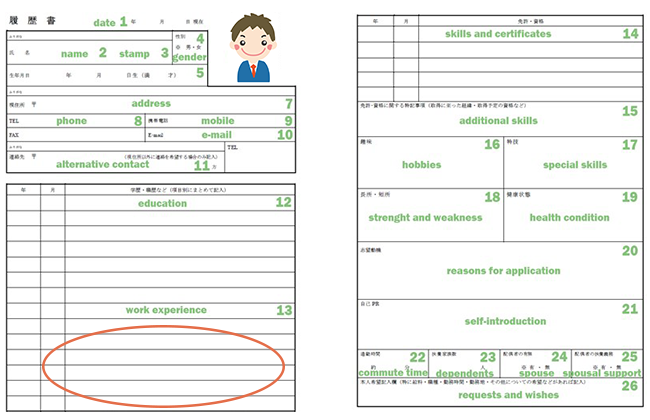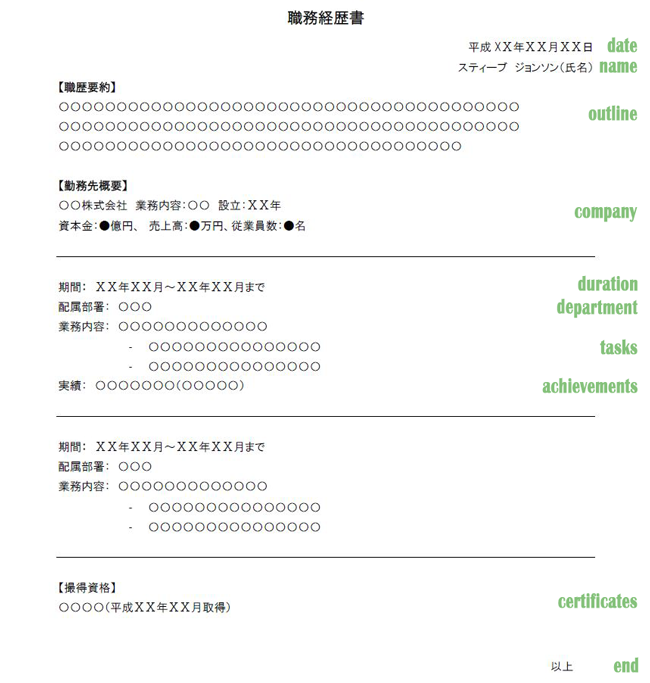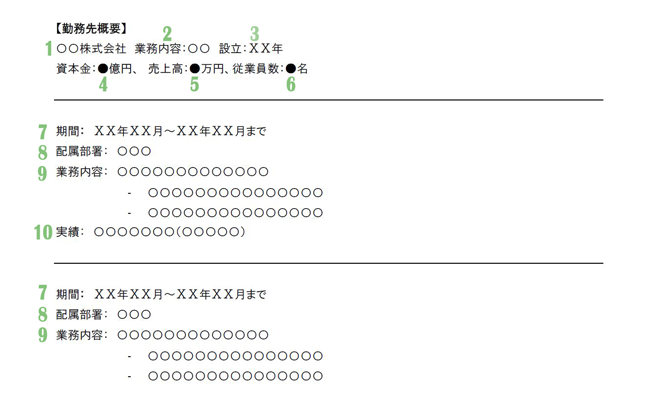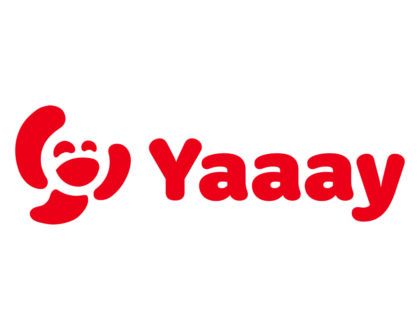Shokumukeirekisho – How to write that other Japanese resume
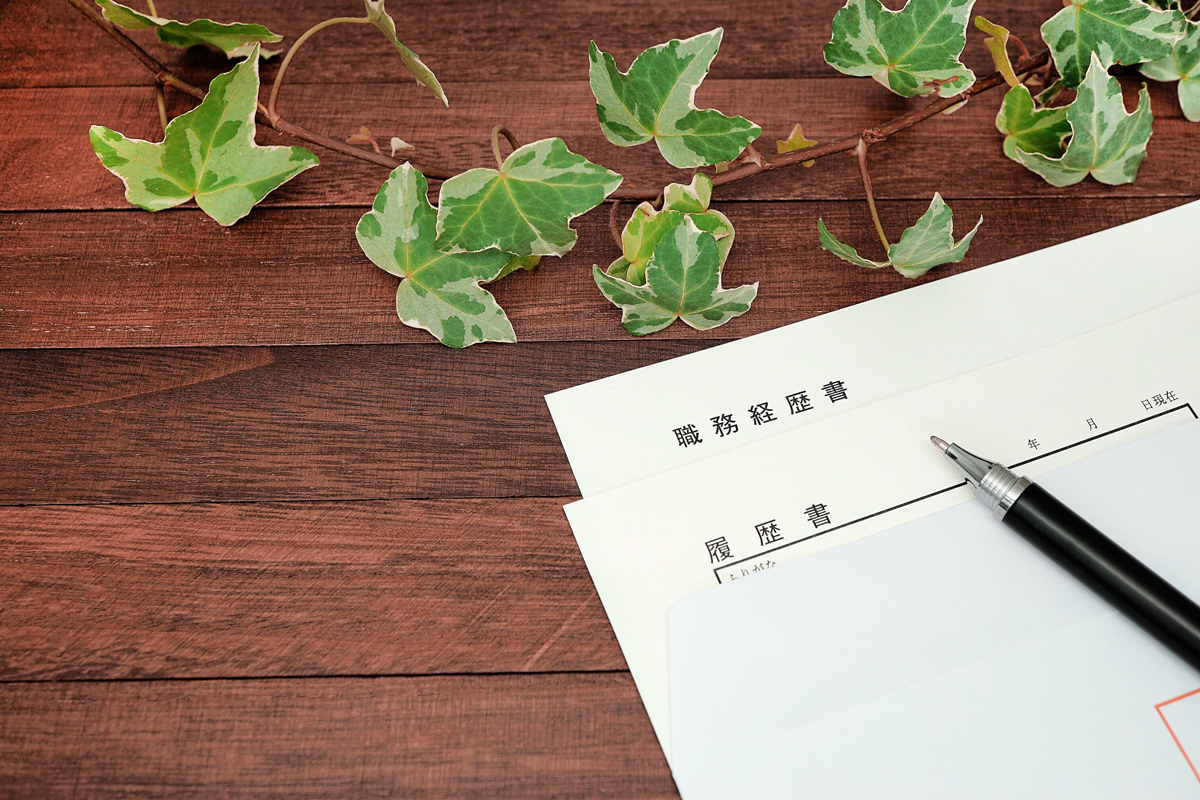
by Madelaine
If you have ever wondered how to possibly fit your work experience into a Japanese resume, you are not alone. The standard rirekisho simply lacks the space, because Japan actually has two types of resumes. The standard one for your general information and a supplement to add work experience when needed.
This tends to cause some confusion for us who are used to using one CV, regardless of whether we start out new, or moving up the career ladder.
コンテンツ
Difference between 履歴書 and 職務経歴書
Standard resume
The rirekisho (履歴書, りれきしょ) is a standardized CV, there to convey basic information about who you are, what skills you have and your educational background. Some space is provided for work experiences, but there is only space to write company name, department and duration of employment. Space to go into more detail and appeal your tasks and achievements is not provided.
Why? Because the rirekisho is only meant to give the recruiter an overview of who you are, a first impression so to speak.
Work experience resume
The shokumu keirekisho (職務経歴書, しょくむけいれきしょ), usually submitted as attachment to the rirekisho will allow you to go into detail about what you were doing at your previous positions. Other than the rirekisho there is no universally agreed on pattern on how to write one.
Both of these documents are essential for the recruiting process. Up until the last interview, recruiters might ask you questions based on what you wrote. To not get blindsided, try to think what the company is likely to ask and prepare your replies accordingly.
Step-by-step guide
The top
1. Title
Top center of your page should be the title. Plain and simple 職務経歴書 (しょくむけいれきしょ) in a bigger font.
2. Date
Leave a free line and write the date. Make it aligned to the right and use the Japanese calendar (平成30年7月2日).
3. Name
Under the date write your full name. Leave a blank space between last and first name.
4. Contact (optional)
If you want you can add your contact information, like phone number or address below your name. Since you already have them on your resume you can safely skip this part.
Overview
This part (No.5) is incredibly important! Recruiters are dealing with lots of applications. So many will make a decision on whether to carefully read your submitted documents, by first scanning this part to see whether you might be a match.
This section should not be longer than 3-4 lines or 200-300 signs. Get to the point. Keep it simple. You want the person reading it to easily understand what kind of work you did until now and what your strengths are that makes you an ideal candidate for the position.
Write at which companies you worked and what you did during your time there. At the end you can add why you applied for the position by mentioning what you want to do that will benefit the company you are applying to.
Professional history
Here you list up your previous positions.
Company overview
Here, in the section called 会社概要 (かいしゃがいよう) you can introduce your previous companies. Don’t just write the name of the company but add concrete information. The more you fill out here, the easier the recruiter can imagine what you did up until now.
- 1. Company name (企業名, きぎょうめい)
- 2. Business type (業務内容, ぎょうむないよう)
- 3. Foundation (設立, せつりつ)
- 4. Capital stock (資本金, しほんきん)
- 5. Number of employees (従業員, じゅうぎょういん)
- 6. Profit (売上高, うりあげだか)
- 7. Business contents (事業内容, じぎょうないよう)
Work Experience
After writing about the company, it’s time to write about your time at said company in your 職歴 (しょくれき).
- 8. Duration of employment (職務に携わった期間 ○年○月~○年○月)
- 9. Department (配属部署, はいぞくぶしょ)
- 10. Tasks (業務内容, ぎょうむないよう)
- 11. Results (実績, じっせき; 成果, せいか)
Repeat this process for all your positions. If you have relevant part-time experience of more than three months, that will be beneficial to the job, you can also list it here.
If you changed positions within your company, you can use a second paragraph for it.
You can adjust this section to your needs. For example, if you won some relevant award, just add a section named 受賞歴 (じゅしゅうれき) and fill it in. Use this to your advantage by highlighting those aspects that make you stand out.
For programmers! Use the below pattern to highlight your skills.
- ■ Tasks (担当業務, たんとうぎょうむ)
- ■ Achievements (開発実績, かいはつじっせき)
Important! List your biggest projects by industry and project type. - ■ Development Environment (開発環境, かいはつかんきょう)
- ■ Development Scale (開発希望, かいはつきぼう)
- ■ Programming Skills (開発スキル, かいはつすきる)
Important! Group skills by OS, programming languages, etc.
Skills and experiences
Certificates and Qualifications
Job relevant qualifications and licenses you can put under 取得資格 (しゅとくしかく) / 特技 (とくぎ). Make sure to not shorten anything but write out the whole name.
PC skills (optional)
For white-collar and creative jobs, you should also mention your computer skills (パソコンスキル). From basic software as Word and Excel (Japanese people love Excel, they use it for anything) up to more specific software like Photoshop, write your skill level for each.
Write language, certification if any and skill level.
This one is optional, but unless you a native Japanese speaker you are better off filling this in. If you want to use a language at work, most companies will expect you to have business level skills.
Appeal
Self-introduction (optional)
No application is complete without a solid piece of self-marketing (自己PR, じこぴあーる). Use this space to appeal your skills and motivation/enthusiasm for the job. Be specific and illustrate on a concrete episode how you showed these skills. The goal is to showcase those skills that will make the recruiter want to meet you.
Usually, you will also have this section in your rirekisho. More space to advertise yourself!
Actually, if you filled it out in your resume you don’t have to write it again here. (Unless the company marks it as necessary.) If you do choose to nevertheless, make sure it is not the same as in your rirekisho.
Reasons for Application
The question of why you applied to the company (志望動機, しぼうどうき) is a central one. So much so, that in most cases you will have to fill it in twice. Once on your resume and once on your work history sheet.
Avoid writing the same at all costs. To differentiate both, write about a special experience that is relevant to the position or to why you are applying.
Don’t put it on too thick, but convey why you want to work at this particular company (and not just in the industry) and how you want to contribute through your work.
Before you start writing
1. Order
There are three ways to structure your shokumu keirekisho.
Chronological
This is the standard way of organizing your resumes in Japan. Especially people with little work experience, or few changes in their workplace use this format.
Since the format is the same that is used in Japanese resumes it is easy for recruiters to read both documents jointly.
Reverse Chronological
This format is less common. It is used by people whose current position is really close to what they want to do at their next position, and by those with over 30 years of work experience. If you have come that far, most people forget how you started out.
Position type
In the upper two versions, you begin each section with the day you started at job X. In the career pattern, you sort by work area instead of time. In Japanese that can be in the form of what you have done until now, or sorted by skills and areas you are strong.
2. Lengths
Keep it realistic and aim for two pages in A4 format, three at most. If you are at the start of your career only one page is absolutely fine too.
3. Goal
The goal of writing resumes is to make the recruiter interested in you. To do that, put yourself in the recruiter’s position when writing.
Is the text easy to read and the important points stand out? Is the text matching the application requirements and the company outlook?
This way, you will only write about things that are relevant to the position and that will give you an advantage over your competitors. Even if you were a celebrated writer in university, if you are applying for an accounting position, you probably have better-suited achievements in other areas.
4. Handwritten
It was standard in Japan to write the CV by oneself. Thanks to PCs and online job-hunting sites, typing your CV and printing is the widely accepted method. That said, it is still possible that you might have to write it by hand.
Even IT companies sometimes ask for handwritten resumes as it shows commitment and care. They might even make the first round of decisions, not based on the content but purely on the evenness of your handwriting.
Checklist
- ✔ Easy to read (paragraphs, layout, size, spelling mistakes)
- ✔ Less than three pages
- ✔ Consistent style (polite, stick to ですます)
- ✔ Your responsibilities and tasks at your previous jobs are clear
- ✔ Use of specific examples and numbers
- ✔ Skills and strength highlighted
- ✔ No white parts or overly large-sized writing (you don’t care about the job)
- ✔ No crammed letters to push in more information (disrespectful to the reader)
All set to start your job-hunt? Find out more here!
Getting ready for your job hunt
Do you have all the info you need and are ready to go? Then go ahead and apply away! However, if your Japanese is rusty or you’re not confident about making it on your own, it might be a good idea to let experts help you with your preparations.
Linguage Japanese Language school, located in central Shinjuku, offers a curriculum that combines Japanese education with job hunt support. At the school, you’ll be able to get direct feedback not only on your shokumukeirekisho, but all other parts of your application as well. Both long-term and short-term courses are available! For more info, check out our detailed article about the school or click the button below to visit the homepage.
Linguage Japanese Language School

